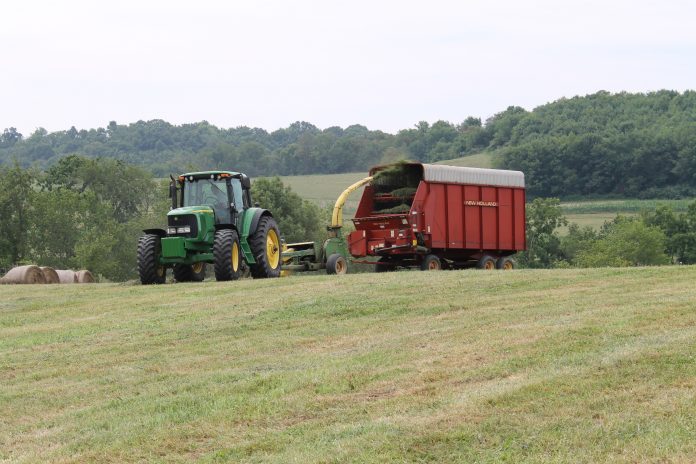It’s been a tale of two summers this year — one very dry and the other incredibly wet. Drought conditions early in the summer provided great forage harvest conditions but limited yields. Rain in mid-July helped with the second and third cuttings, but the harvest windows have been very short.
Most locations throughout northeast Ohio have received 5 to 8 inches of rain since Aug. 1 with some areas receiving over 10 inches. Shorter days and cooler temperatures have increased the length of time for soil to dry after rainfall.
Taken all together, producers are frustrated as they try to get forages harvested without causing damage to the crops or fields. With corn silage harvest upon us, let’s revisit soil compaction and, more importantly, how to avoid it.
What is compaction?
Soil typically consists of 50% solid material (inorganic and organic material) and 50% pore space (air and water). Compaction occurs when the soil is compressed, reducing the pore space and making the soil denser. Dense soils have less water-holding capacity and limit air movement.
When adequate pore space is available, roots will grow deep and move easily through the soil profile. In compacted soils, roots are often stunted and will grow horizontally along the furrow. Reduction in the size of the root zone limits nutrient uptake and overall crop development. Studies from Minnesota have shown corn can be up to 11% shorter in compacted areas.
There are many ways soil can be compacted, but the primary culprits in forages are axle load, ground pressure, soil moisture and the number of trips across the field. Axle load is how much weight is being carried on each axle, and the higher the axle load, the deeper the compaction. Axle loads up to five tons can cause surface compaction but are not likely to cause compaction to subsoil. Heavier loads of 10 tons or more can compact the soil 20 inches deep.
Reducing compaction
Adding duals or flotation tires to harvest equipment can help with compaction. Research from Europe showed that using flotation tires did reduce topsoil compaction and deformation, but there was no difference in subsoil compaction compared to the use of standard tires. So, while decreasing ground pressure with duals or flotation tires is a good approach to prevent ruts and minimize topsoil compaction, decreasing axle loads is still the best option.
Another way to decrease ground pressure is to use newer increased flexion, very high flexion or radial tires. These tire designs can carry heavier loads at lower pressure than the old bias-ply tires, but they are more expensive. However, on any tire, operating at the correct tire pressure will increase traction, reduce ground pressure and prevent topsoil compaction.
Compaction risk is highest in wet or damp soils. Back in June, our dry soils could support high axle loads, but that is not the case in the current conditions. Mud can cause rutting, slipping and generally miserable harvest conditions.
While this mostly impacts topsoil, wet soil under tires is like a hydraulic press, causing that weight to be distributed down into the subsoil. This is why subsoil compaction is such an issue with wet soils. The best approach is to wait for the soils to dry out, but that is not always practical or possible.
Identification
Soil compaction is usually compounded by repeated traffic over several harvests. Grain carts, silage wagons and harvest equipment generally follow a similar path each year. You may even notice poor crop stands in your high-traffic areas. Other times compaction is not as easy to locate.
To help identify problematic areas, use a penetrometer to measure the pressure required to press the metal probe into the soil. Taking measurements randomly across a field will help identify compacted areas. Although there is no accepted standard for soil compaction because of different soil types, values above 300 psi are generally considered compacted. A penetrometer will also identify how deep the compaction goes.
Shallow compaction can be fixed with tillage, but tillage can also be a double-edged sword. While a chisel plow can break up topsoil compaction, if not done correctly, it can increase subsoil compaction, decrease soil health and increase erosion.
Deep rippers are becoming a popular option but require care. This type of tillage can create a deeper plow pan that will, in turn, require a deeper ripper to fix, setting you off into a bad cycle.













